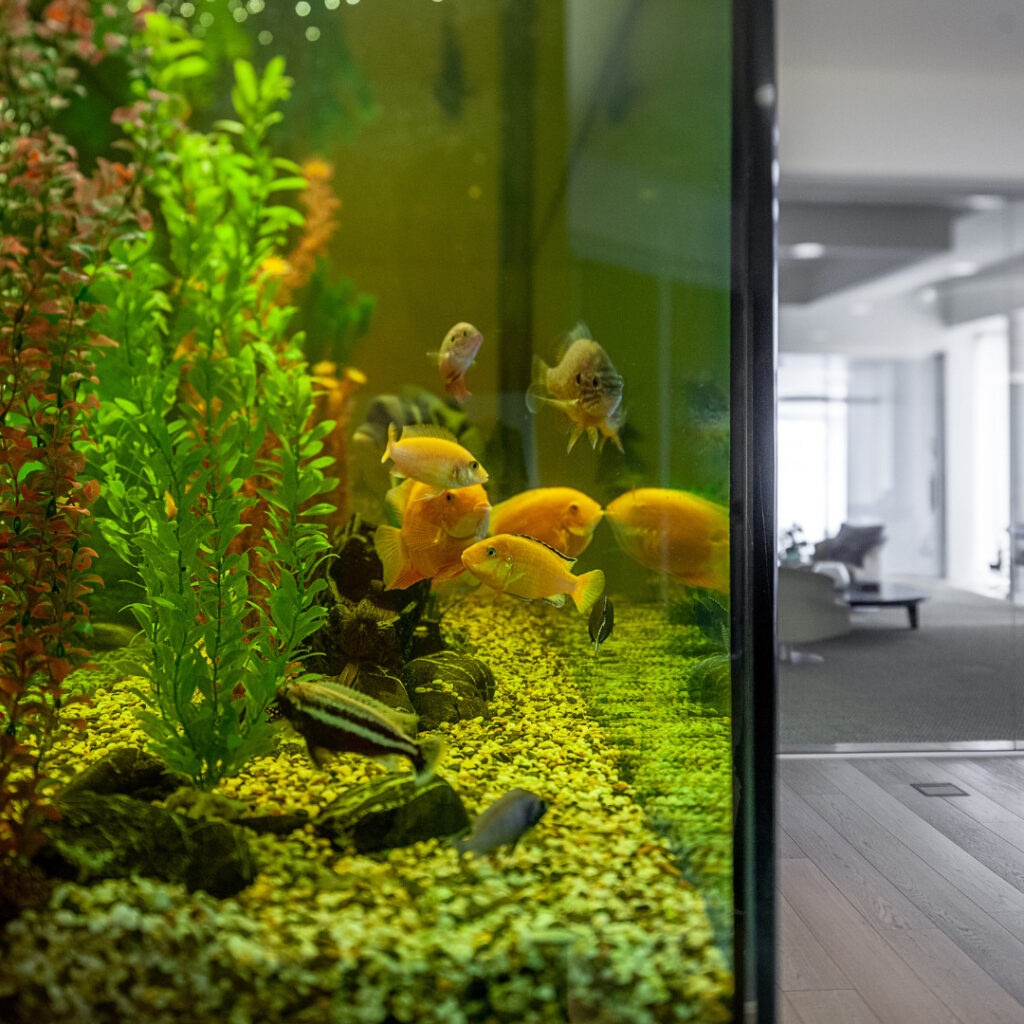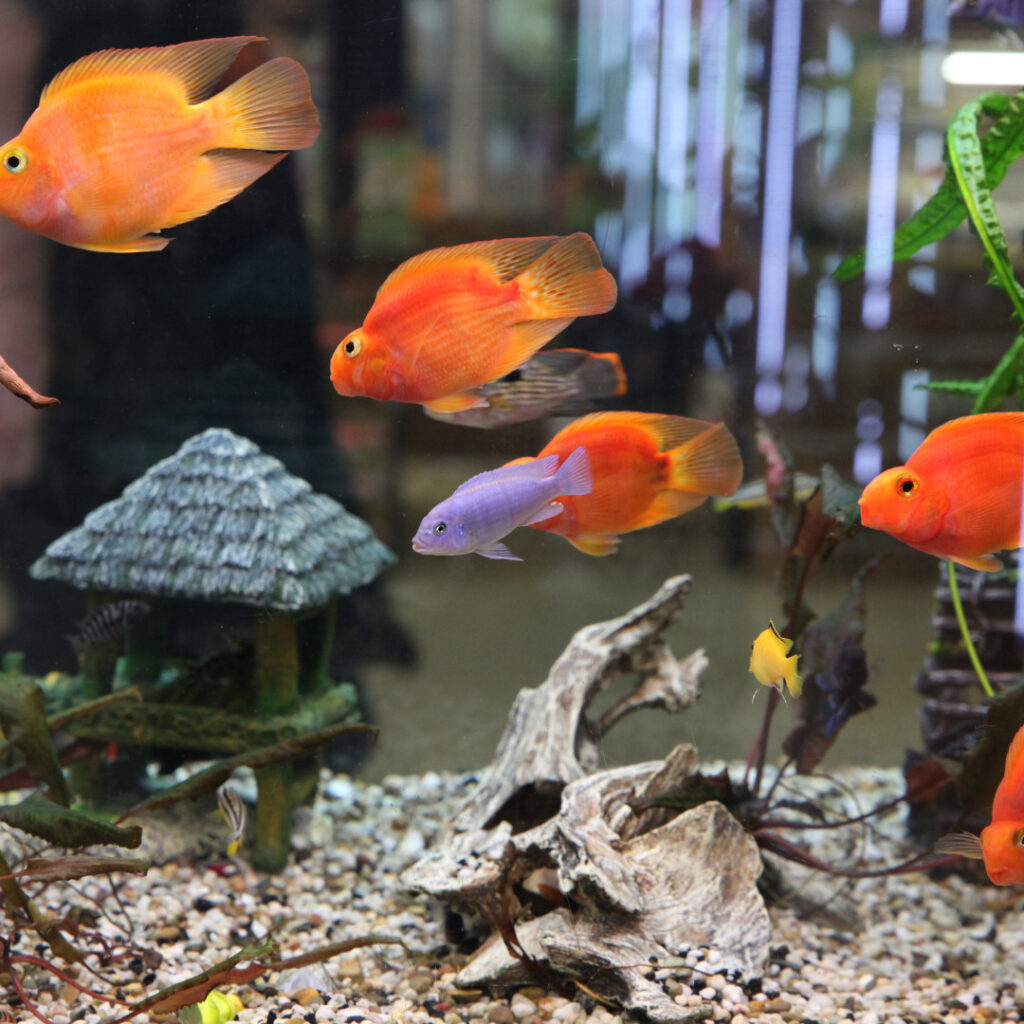Breeding fish in an aquarium can be a fascinating and rewarding experience for aquarium hobbyists. One of the most intriguing aspects of fish breeding is witnessing the process of fish laying eggs.
Many fish species reproduce by laying eggs, then incubating until they hatch into fry. This natural phenomenon provides an opportunity to observe the intricate reproductive behaviors of fish within the controlled environment of an aquarium. Understanding the basics of fish egg laying, from the preparation of the breeding tank to the subsequent care required for the eggs, allows aquarium enthusiasts to actively participate in the remarkable journey of new life unfolding before their eyes.

What to do if my fish laid eggs in my fish tank?
If your fish has laid eggs, here are some steps you can take:
- Provide a Suitable Environment: Create a separate breeding tank or area within the main tank to protect the eggs from other fish and potential predators. Ensure that the water conditions, temperature, and lighting are appropriate for your specific fish species. Some fish may require specific water parameters or conditions for successful egg development.
- Monitor Water Quality: Maintain optimal water quality to ensure the survival of the eggs. Regularly test the water parameters such as pH, ammonia, nitrite, and nitrate levels, and make necessary adjustments or water changes if needed. Stable and clean water conditions are essential for the health of the eggs.
- Protect the Eggs: Depending on the fish species, you may need to take additional steps to protect the eggs. Some fish may require a separate breeding mop, mesh, or substrate for the eggs to attach to and prevent them from being eaten or damaged. Consult species-specific information to understand the best method to protect the eggs.
- Observe and Document: Keep a close eye on the eggs and document their progress. Monitor their color, size, and any changes that occur. This can help you identify potential issues or signs of successful development.
- Remove Adult Fish: If the eggs are in a community tank, it’s advisable to remove the adult fish to prevent them from eating the eggs. However, some fish species exhibit parental care, and the adults may need to stay with the eggs to provide protection. Research the specific breeding behavior of your fish species to determine whether the parents should be removed or left in the tank.
- Feed the Fry: Once the eggs hatch, the fry (baby fish) will need appropriate food. Research the dietary needs of the specific fish species and provide suitable fry food, such as infusoria, baby brine shrimp, or commercially available fry food.
- Provide Shelter and Cover: After hatching, the fry will need places to hide and seek shelter. Add appropriate plants, decorations, or structures to the breeding tank to provide cover and protection for the fry.

How do you keep fish eggs from getting moldy?
To prevent fish eggs from getting moldy, you can take the following measures:
- Maintain Water Quality: Ensure that the water parameters are within the appropriate range for the fish you are breeding. Poor water quality can stress the eggs and make them more susceptible to mold. Regularly monitor and maintain proper filtration, aeration, and water circulation in the breeding tank.
- Maintain Proper Oxygen Levels: Adequate oxygenation is essential for the health of fish eggs. Use an air stone, diffuser, or gentle water movement to maintain oxygen levels in the tank. This promotes healthy development and reduces the risk of mold formation.
- Remove Unfertilized or Damaged Eggs: Inspect the eggs regularly and promptly remove any unfertilized or damaged ones. These eggs can decompose and become a breeding ground for mold and bacteria, harming healthy eggs.
- Control Humidity and Temperature: Mold thrives in damp and warm environments. Ensure that the humidity in the breeding tank is not excessively high, as it can promote mold growth. Additionally, maintain stable and appropriate temperatures for the specific species of fish. Consult species-specific guidelines for recommended temperature ranges.
- Provide Proper Ventilation: Allow for adequate air circulation around the breeding tank to prevent moisture buildup. This helps maintain a healthy environment and reduces the chances of mold growth.
- Use Medications or Anti-Fungal Treatments: If you notice the presence of mold on the eggs, you can use aquarium-safe anti-fungal treatments as directed. Follow the instructions carefully and ensure that the treatment is safe for the species of fish you are breeding.
Can fish eggs survive without parents?
Yes, fish eggs can survive without their parents. In fact, many fish species have a reproductive strategy where the adults lay eggs and provide no parental care. These species rely on the conditions of the environment, such as water quality and temperature, for the development and survival of the eggs.
Fish eggs contain a yolk sac that provides the necessary nutrients for the developing embryos. As long as the eggs are in suitable water conditions and receive adequate oxygenation, they can develop and hatch without parental involvement.
However, there are also fish species that exhibit parental care, where one or both parents protect and care for the eggs until they hatch. In such cases, the presence of the parents can enhance the survival rate of the eggs by guarding them against potential threats and ensuring optimal conditions.

How long does it take for fish eggs to hatch in a tank?
The time it takes for fish eggs to hatch can vary significantly depending on the fish species. Each species has its own specific incubation period. Here are some general estimates for common aquarium fish:
- Betta Fish: Betta fish eggs typically hatch within 24 to 48 hours, depending on the water temperature.
- Guppies: Guppy eggs usually take around 2 to 3 weeks to hatch, depending on water temperature and conditions.
- Goldfish: Goldfish eggs can take anywhere from 2 to 7 days to hatch, with the duration influenced by water temperature.
- Tetras: Tetra eggs generally hatch within 24 to 48 hours, again depending on water temperature.
- Angelfish: Angelfish eggs typically hatch in 48 to 60 hours, but the time can vary based on temperature and other factors.
It’s important to note that these timeframes are approximate and can be influenced by factors such as water temperature, water quality, and the specific conditions provided for the eggs.
Do fish guard their eggs?
Yes, many fish species exhibit parental care and actively guard their eggs. Both male and female fish can take part in guarding and protecting the eggs, depending on the species. Here are a few examples:
- Mouthbrooders: Some fish species, such as cichlids, are mouthbrooders. The female lays the eggs, and then one or both parents take the eggs into their mouths to protect them until they hatch. During this time, the parents may not eat and focus solely on caring for the eggs.
- Bubble Nest Builders: Betta fish (Siamese fighting fish) are known for their bubble nest building behavior. The male creates a bubble nest at the water’s surface using air bubbles and saliva. After the female lays the eggs, the male collects them and places them into the nest. He guards the nest and the hatching fry, and if any eggs or fry fall out, he will put them back into the nest.
- Mouthbrooding Catfish: Some species of catfish also exhibit mouthbrooding behavior. The male or female catfish incubates the eggs in their mouth until they hatch. They may occasionally release the eggs to feed and then gather them back into their mouth for protection.
- Egg Scatterers: Some fish scatter their eggs over plants, rocks, or the substrate. While they may not actively guard the eggs, they may defend the general area and deter potential threats from approaching.
The level of parental care and guarding behavior can vary among fish species.
What percentage of fish eggs survive?
The survival rate of fish eggs can vary significantly depending on several factors, including the species of fish, environmental conditions, parental care, and potential threats. It is challenging to provide an exact percentage as it can vary greatly between species and specific circumstances. However, it’s worth noting that in the wild, the survival rate of fish eggs is generally low, with a significant portion of eggs failing to develop into viable fry or surviving to adulthood.
In controlled breeding environments, where optimal conditions can be provided, the survival rates can be higher. With appropriate water quality, temperature, and protection from predators, the chances of egg survival can improve.
Additionally, fish species that exhibit parental care, such as mouthbrooders or bubble nest builders, tend to have higher survival rates for their eggs due to the active protection provided by the parents. The parents guard the eggs against predators and maintain optimal conditions for their development.

What does it mean when fish eggs turn white?
When fish eggs turn white, it usually indicates that they are not viable or have experienced some sort of problem. Here are a few possible explanations for white fish eggs:
- Unfertilized Eggs: If the eggs were not fertilized by a male fish, they will not develop and will typically turn white and opaque. Unfertilized eggs are not viable and will not hatch.
- Fungus or Mold: White fuzzy growth on fish eggs is often a sign of fungal or mold infestation. Mold can develop on eggs if the water conditions are unsuitable, such as poor water quality or high levels of organic matter. Fungal or mold growth can negatively affect the viability of the eggs and prevent successful hatching.
- Dead or Dying Embryos: If the embryos inside the eggs have died or are not developing properly, the eggs may turn white. This can be due to genetic issues, poor water quality, temperature fluctuations, or other factors that compromise the health of the embryos.
- Poor Water Quality: Unfavorable water conditions, such as high ammonia or nitrate levels, low oxygen levels, or extreme pH fluctuations, can negatively impact the eggs. Poor water quality can lead to egg discoloration, including turning white.
If you notice white eggs, it’s essential to assess the overall health and conditions of the breeding tank or environment. Monitor water quality parameters, ensure appropriate water conditions, and provide adequate care for the eggs. However, if a significant number of eggs have turned white, it may indicate an issue with the breeding process or underlying problems that need to be addressed.
Why do my fish eat their eggs?
Fish may eat their own eggs for several reasons, and it can be influenced by various factors. Here are some possible explanations for why fish eat their eggs:
- Lack of Parental Care Instinct: Some fish species lack strong parental care instincts or have not developed the behaviors necessary to protect their eggs. In such cases, the fish may not recognize the eggs as their own or understand the need to protect them.
- Stress or Inadequate Environment: Stressful or unsuitable environmental conditions can trigger fish to eat their eggs. Factors such as poor water quality, inadequate nutrition, insufficient hiding places or nesting sites, overcrowding, disturbances from tank mates, or external factors can contribute to stress and disrupt parental behaviors.
- Lack of Experience: Young or inexperienced fish breeding for the first time may not exhibit proper parental care behaviors. They may inadvertently or instinctively consume the eggs due to inexperience or confusion.
- Abnormal or Unhealthy Eggs: Fish may eat eggs that are not developing properly, are infertile, or are infected with fungus or other pathogens. This behavior can be a natural instinct to remove and prevent the spread of potential threats within the breeding environment.
- Cannibalistic Tendencies: Some fish species, particularly certain cichlids, exhibit natural cannibalistic tendencies. In these cases, the parents may eat the eggs or fry as a part of their normal reproductive behavior.
- Nutritional Needs: In certain situations, fish may consume their eggs to meet their nutritional needs. This behavior is more common in species with limited or irregularly available food resources.
Providing a suitable and stress-free environment, ensuring proper nutrition, and selecting fish species known for their parental care instincts can help reduce the chances of eggs being eaten.
How to tell if my fish laid infertile eggs in home aquariums?
The best way to determine whether fish eggs are infertile is by noticing these observations:
- Lack of Development: If the eggs do not show any signs of development over time, it could indicate that they are infertile. Fertile eggs typically undergo changes such as becoming translucent, developing eyes or embryos, or showing signs of growth. If the eggs remain unchanged and do not show any signs of development, they may be infertile.
- Discoloration or Opacity: Infertile eggs may appear discolored or opaque. They may have a cloudy or white appearance, indicating that they have not been fertilized or are not viable.
- Fungal Growth: If the eggs become covered with fungus or mold, it suggests that they are infertile or dead. Fungal growth often occurs on improper fertilized eggs or lack of viability.
- Lack of Parental Care: If the parents do not exhibit any protective behaviors towards the eggs or show signs of actively attending to them, it could indicate that the eggs are infertile. Parental fish generally show interest in caring for and guarding viable eggs.
- Observing the Breeding Process in different species: If you were present during the breeding process and witnessed no spawning or observed that the male fish did not fertilize the eggs, the eggs are likely infertile.
It’s important to note that some species may have healthy fish eggs that are naturally difficult to identify as fertile or infertile without specialized techniques or equipment.
There are many different ways to protect fish eggs in an at-home aquarium. It is always a good idea to stay observant for best results. Good luck on your journey!

Leslie
Thursday 14th of April 2011
I am 44 y.o. and have NEVER even had a professional facial! I have had one massage finally...about 2 yrs ago. We took Christmas money from T's gram and used it for a couple's massage. I think it's due to my cheapskate family mentality or something....I would feel so guilty spending $$ on that stuff. It looks like fun - the hot rock therapy...the beachfront massages, etc. etc. etc!
Maria
Wednesday 13th of April 2011
Your skin is flawless! What products do you use on your skin? Do you have a skincare routine? Beautiful skin!!!
Vera
Thursday 14th of April 2011
SO not flawless - i have rosacea and it's not fun managing. i use a slew of products but my moisturizer is DDF. It is awesome! :)